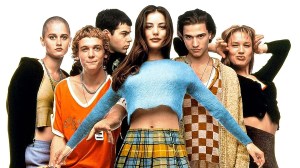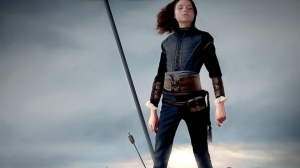I thought myself done with Game of Thrones, and I hardly think I’m the only one. Between the clumsily executed final season of the HBO series and the seemingly endless wait for The Winds of Winter, I was content to leave George R.R. Martin’s fantasy universe — which I had once been mildly obsessed with — behind for good. I may even have been subconsciously rooting for House of the Dragon — HBO’s first Game of Thrones spinoff — to fail that, I might not have to become reinvested in that world. I hadn’t even finished watching the first episode of House of the Dragon before I realized that was no longer the case. All it took was one shot of a dragon gliding over King’s Landing backed by Ramin Djawadi’s score to hook me. By the end of the episode, I was again under Westeros’ spell.
Videos by ComicBook.com
House of the Dragon takes place almost two centuries before Game of Thrones begins. The show uses Martin’s Fire & Blood, a historical overview of the Targaryen dynasty, as its basis. House of the Dragon specifically hones in on the era leading up to “The Dance With Dragons,” the Targaryen civil war of succession mentioned in Game of Thrones. King Viserys I Targaryen (Paddy Considine) has struggled to bear male heirs. When any hope of having a son seems to die with his wife, Viserys must consider, in his grief, to whom his throne should pass: his brother, the ambitious and unpredictable Daemon Targaryen (Matt Smith), or his daughter, “The Realm’s Delight,” Rhaenyra Targaryen (Milly Alcock). Viserys’ choice, and unexpected future choices, sets into motion a chain of events that will threaten to tear the realm apart.
Despite the high stakes, House of the Dragon is much less focused on the politics of the matter and more concerned with its characters. Over the years, viewers see Rhaenyra grow from a daydreaming child to a determined young adult. Alcock shows a disarming versatility in her performance, able to subtly alternate between entitled child, ambitious princess, and curious young woman. Smith brings a cunningness to Daemon while capably bringing all of the character’s nuanced frustrations to the fore. Considine shines with his warm turn as Viserys, a character made tragic by his desire to do good and right by his daughter while always seeming to make the wrong choices. There’s not a poor performance among the cast of these first five episodes, with Rhys Ifans’ calm and confident take on Otto Hightower, the King’s Hand, contrasting beautifully with Emily Carey’s nerve-wracked turn as Otto’s daughter, Alicent.
What’s enchanting about House of the Dragon‘s first five episodes (the sixth is something else entirely, which I’ll get to) is how it differs from Game of Thrones. Viewers first visited Westeros via a sweeping, epic saga, bouncing back and forth between half a dozen subplots set in many locations. House of the Dragon presents itself as a focused drama set almost entirely within the walls of the Red Keep. Where much of Game of Thrones‘ plot is motivated by the, at times, cartoonish ambitions of its cast of characters, House of the Dragon is more intimate and built on complex and conflicting relationships. It’s a story of clashing emotions, family bonds, and familiarity amidst comings of age, made infinitely more complicated by the responsibility of royalty. As a prequel, House of the Dragon cannot rely on the same level of mystery and intrigue as Game of Thrones. Instead, it tells much more personal stories fueled by the desire to define oneself in the face of societal norms and assumptions, adding personality and pathos to the comparatively dry source material.
And it all looks gorgeous. The medieval grandeur of the sets and fantastic special effects that fans of Game of Thrones all remain intact. The directing is impeccable, especially the debut episode directed by Miguel Sapochnik, who creates captivating frames with light and shadow. Game of Thrones‘ signature graphicness is also intact, with plenty of violence and flesh. However, it’s also turned in a new direction. Much of the story is about how Westeros views the role of women, a theme emphasized by unflinching portrayals of childbirth, often contrasted directly with the glorified violence that men inflict upon each other, at times simply for sport.
However, things take a turn in the show’s sixth episode. Halfway through this first season, things change as older actors replace several of the core cast to play older versions of those characters, and a new batch of young characters join. It’s a jarring transition, particularly as the subtle performances of the younger cast fall away, replaced, in some cases, by much bigger performances from the adult cast and weirder energy from the new children. At the same time, pace and plot take on a more familiar shape as ambitious schemers make bold moves, and war seems on the horizon. It isn’t bad, but it is much more like what I expected from a Game of Thrones series. After being delighted by the ways House of the Dragon‘s first five episodes surprised me, that pivot did drain some of my excitement.
Yet, there are far worse things than becoming more Game of Thrones. After all, despite the backlash to the final season, Game of Thrones was some of the best genre television ever created for the vast majority — if not the entirety — of its run. But even if the remainder of House of the Dragon falls into a too-familiar pattern, that cannot take away from these first five episodes being beautifully crafted and compelling television. Game of Thrones fans and newcomers should settle in for an excellent five weeks, and maybe more.
Rating: 4 out of 5
House of the Dragon premieres on August 21st on HBO and HBO Max.








